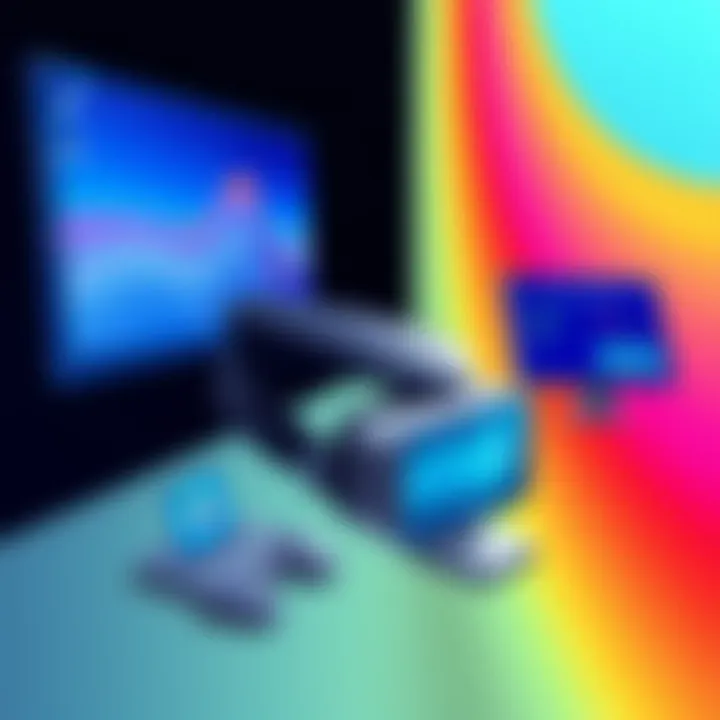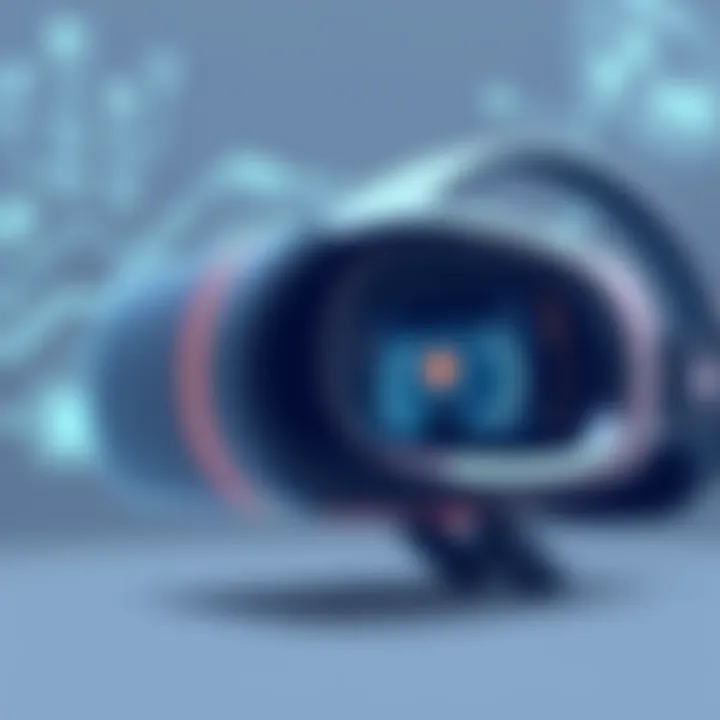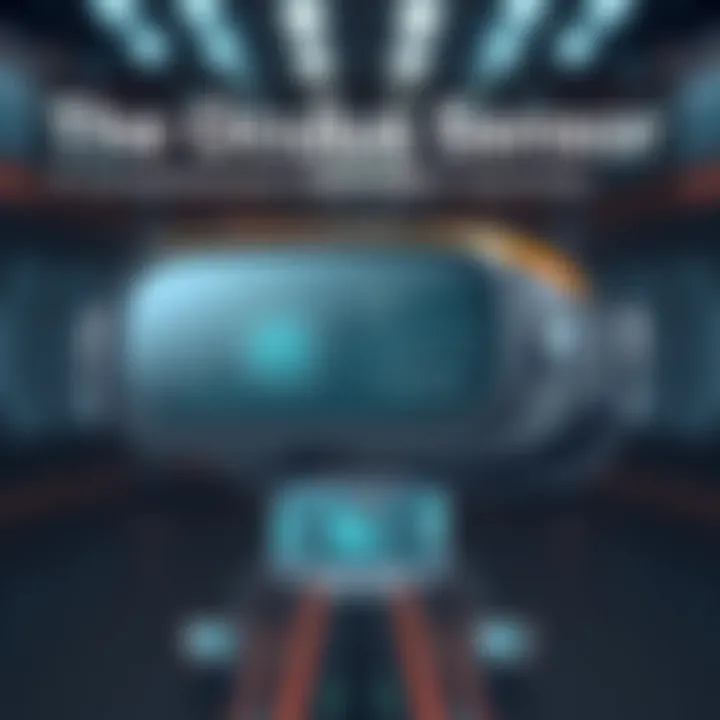Exploring the Oculus Sensor: Impact on Virtual Reality


Intro
Virtual reality has transformed the way we engage with digital spaces, immersing users in experiences that go beyond traditional forms of interaction. At the very heart of this transformation lies the Oculus Sensor, a device that enables precise tracking and interaction within virtual environments. Understanding its intricacies unravels a deeper appreciation for the world of VR gaming, simulation, and practical applications.
As we dive into the diverse elements of the Oculus Sensor, from its key specifications to the nuanced performance it offers in real-world scenarios, tech enthusiasts and casual users alike will gain valuable insights. This comprehensive examination breathes life into the technical jargon, demystifying how these sensors work and their relevance in the development of virtual reality. Whether you're a professional in the tech industry or just someone drawn to the thrills of gaming, this exploration will illuminate everything you need to know about the Oculus Sensor's impact and future.
Preamble to Oculus Sensors
The way we engage with technology has changed remarkably, especially within the realm of virtual reality. Oculus Sensors have become a cornerstone in creating immersive experiences that transport users into new worlds. Understanding the significance of these sensors in VR applications is crucial for both developers and users alike. They weave together a narrative that enhances interaction and realism, making the digital realm feel as tactile and immediate as our physical surroundings.
Oculus Sensors are designed to track your movements with impressive precision, an essential feature that allows for a fluid experience in various applications, such as gaming and simulation. However, it's not just about tracking physical movements; it also includes understanding how these devices interpret gestures and respond to user interactions. The benefits of Oculus Sensors extend beyond entertainment, finding ground in training simulations, therapeutic use, and educational tools. By examining these elements, we discover not only how they work but also their broader implications in society today.
In the following sections, we'll establish a clearer definition of Oculus Sensors and explore their historical context. We aim to shed light on the evolution of VR sensor technology, illustrating how innovations have paved the way for today's advanced devices and inviting you to consider the future possibilities they hold.
Technical Specifications
Understanding the technical specifications of Oculus Sensors is crucial for comprehending their role in virtual reality systems. These specifications not only underpin the performance of the sensors but also inform users about their capabilities and limitations. A clear grasp of these elements allows both developers and consumers to optimize the virtual reality experience, making it both immersive and functional. Furthermore, as technology advances, the nuances of these specifications evolve, impacting future applications in varied fields from gaming to healthcare.
Overview of Sensor Features
Oculus Sensors are renowned for their robust features designed to enhance user interaction within virtual spaces. These sensors are equipped with several groundbreaking technologies, including:
- 360-degree Tracking: This feature allows sensors to track movements from any angle, enabling a more dynamic interaction as users navigate their virtual environment.
- Accelerometer and Gyroscope: Combined, these tools enhance the motion sensing capabilities, making it possible for the sensor to detect both the orientation and linear motion of the device.
- Infrared Sensors: These play a pivotal role in ensuring that tracking is accurate even in varied lighting environments, providing an uninterrupted experience regardless of external conditions.
The amalgamation of these features underlines the sophisticated design of the Oculus Sensor, offering users a seamless integration into their virtual worlds.
Sensor Resolution and Tracking Range
Resolution and tracking range are pivotal in defining the quality of virtual reality experiences. High sensor resolution translates into finer detail and clarity, enabling users to see virtual landscapes and elements crisply and clearly. For instance, Oculus Sensors provide high precision in position and orientation tracking, ensuring that movements translate smoothly in the virtual realm.
In practical terms, here’s how these elements affect user experience:
- Position Accuracy: High-resolution sensors enhance spatial awareness, making interactions feel more natural. Users can lean in, reach out, and turn without experiencing lag or disorientation.
- Tracking Range: A wide tracking range allows users to move freely within their physical space without losing the connection with the virtual world. This aspect is key in applications such as room-scale VR, where movement space is essential.
Integration with Oculus Hardware
The integration of sensors with other Oculus hardware is a major boon for users. This synergy amplifies the user experience by ensuring that all components work harmoniously to deliver a cohesive virtual reality experience. Here’s how integration plays a vital role:
- Seamless Communication: Sensors are engineered to communicate effectively with Oculus headsets and controllers, resulting in low latency responses. This means that user actions translate immediately into the virtual world, enhancing immersion.
- Complementary Functionality: When combined with Oculus Rift or Quest, the sensors enable advanced functionalities such as hand tracking and spatial audio. This enhances the layers of interaction, making every moment more engaging.
The coherent interplay between Oculus Sensors and its hardware ensures that the user's journey through the virtual landscape is as intuitive and enjoyable as possible.
Functionality of Oculus Sensors
The functionality of Oculus Sensors is central to understanding how virtual reality transforms user experiences. This technology provides accurate tracking and interaction, paving the way for immersive environments that captivate users. Each aspect of sensor functionality not only enhances gameplay but also influences how effectively VR can be integrated into various practical applications. As we dig into this topic, it's crucial to consider how these sensors operate, their interaction modalities, and how they elevate immersion to unprecedented levels.


How the Sensor Tracks Movements
At the core of Oculus Sensors’ functionality is their ability to track movements meticulously. They utilize a combination of infrared technology and machine learning algorithms to capture the user's position in real time. When a gamer turns their head or shifts their body, the sensors detect these movements immediately, relaying that data to the VR system.
Accurate motion tracking is vital because it allows users to interact with the virtual world as naturally as possible.
For example, with advanced gyros and accelerometers inside the headset, users can experience head movements fluidly. In practical terms, this means the technology can understand the user’s posture, allowing for nuanced movements when gaming or navigating virtual landscapes.
Some key elements of movement tracking include:
- Position Tracking: Sensors gauge the location of the headset relative to the play area.
- Orientation Detection: They assess the angle of the headset, helping create an authentic 360-degree view.
- Latency Reduction: Algorithms work tirelessly to minimize delays between movement and visual feedback, enhancing user comfort and reducing disorientation.
Interaction Mechanisms
Interaction in virtual reality goes beyond simple point-and-click methods. Oculus Sensors facilitate a multifaceted approach to engaging with the VR environment, heightening the realism of experiences. From hand gestures to voice commands, these sensors enable several interaction mechanisms:
- Hand Tracking: This feature lets users use their hands to perform actions like grabbing or swiping. The sensors translate specific gestures into in-game responses, creating a natural and intuitive interface.
- Controller Integration: By using handheld controllers embedded with sensors, users can execute complex actions. The precise tracking allows for movements like throwing or pointing, translating seamlessly into the virtual space.
- Voice Recognition: Advanced software enables sensor interaction via voice commands, allowing users to navigate menus and initiate actions without needing physical input.
The spectrum of interactions afforded by Oculus technology enriches user engagement and enjoyment.
Role in immersive experiences
The role of Oculus Sensors in crafting immersive experiences cannot be overstated. They function as the bridge between the user and the digital universe, correlating physical movements and interactions with the virtual realm. This synchronization forges a more believable and captivating user experience.
Immersion is achieved through:
- Realistic Movement Simulation: Users feel as if they are truly 'in' the game, reacting naturally to what they see, rather than merely observing it from a distance.
- Environmental Reactivity: As users move their body, the VR environment adjusts accordingly. This constant feedback loop creates a sense of presence and makes the experience far more engaging.
- Heightened Sensory Engagement: The feedback from the sensors, coupled with audiovisual cues, creates a holistic environment where sight, sound, and movement coalesce.
Application Areas
The Oculus Sensor has significantly impacted multiple domains, each extracting different benefits from its unique capabilities. By facilitating intricate interactions and elevating user experiences, the sensor's technology extends far beyond gaming, resonating with developers, educational institutions, and medical professionals. Below, we delved into various application areas of the Oculus Sensor to highlight how it has become an essential tool in these fields.
Gaming and Entertainment
Gaming and entertainment sectors have reaped some thrilling rewards thanks to the Oculus Sensor. By allowing spatial awareness and precise motion tracking, players can fully immerse themselves in virtual environments. Imagine standing in a medieval castle while trying to swing a sword at a dragon, not just pressing buttons but feeling the weight of your actions. This level of engagement is reshaping how games are designed.
- Interactive Gameplay: Sensors enable intuitive control schemes, allowing players to physically act within digital realms. This engagement brings about a sense of presence that flat screens simply can't achieve.
- Realistic Graphics and Physics: The combination of advanced sensors and high-quality graphics create lifelike interactions. A player not only sees their virtual surroundings, but they can also experience them, generating emotionally resonant moments.
"The real power of VR comes from the ability to feel as if you're actually there, and Oculus Sensors play a pivotal role in making that happen."
Training and Simulation
Shifting gears from pure entertainment, the Oculus Sensor shines brightly in training and simulation environments. Many industries leverage VR to provide realistic training experiences, from flight simulations for pilots to safety drills for construction workers. The immersive nature of the technology allows trainees to practice without real-world consequences.
- Risk-Free Environments: Trainees can make mistakes without jeopardizing safety, learning valuable lessons without the stakes attached to real tasks.
- Endless Customization: Scenarios can be tailored to specific training needs, ensuring that individuals engage with material relevant to their tasks.
- Enhanced Retention: Studies suggest that learners retain information more effectively when it's experienced rather than merely observed. This sensory engagement helps to cement acquired skills and knowledge.


Therapeutic Uses
The therapeutic potential of the Oculus Sensor is gaining traction in the medical community. This technology is being utilized in various forms of therapy, aiding in recovery and mental health treatments. Virtual reality can assist in exposure therapy for those battling phobias or PTSD, offering a controlled environment to confront fears.
- Pain Management: Some studies show that VR can distract patients during painful procedures, thus minimizing their discomfort.
- Physical Rehabilitation: For individuals recovering from injuries, gamified therapeutic exercises can make physical rehab less tedious, motivating patients to engage fully.
- Mental Health Enhancement: The immersive experiences designed for stress relief and mindfulness can provide users with platforms to relax and find peace amidst chaos.
By understanding the vast application areas of Oculus Sensors, it becomes evident that their contributions are far-reaching and influential across various industries. This technology not only enhances user experience in entertainment but also promotes learning in training environments and encourages healing in therapeutic settings.
Impact on User Experience
When discussing the Oculus Sensor, its impact on user experience stands as a cornerstone. This section explores how the sensor enhances interactions and ultimately shapes the virtual reality landscape. The importance of user experience cannot be understated. It influences how users perceive and enjoy the VR environment, significantly dictating their overall satisfaction and willingness to engage.
Enhancing Immersion
The first notable benefit of Oculus Sensors is their ability to enhance immersion. Immersion can be defined as the feeling of being physically present in a virtual environment. To achieve this, the sensor employs cutting-edge tracking technology that captures subtle movements, allowing for fluid transitions and interactions within the VR space. Consider the way a player's head movements translate seamlessly into the in-game environment. If the sensor is accurate, players will feel as though they are actually inside the game. This responsiveness cultivates a sense of realism that traditional forms of media simply cannot match.
To illustrate, in popular VR games like Beat Saber, each swing of the controller is tracked perfectly, imparting the sensation that users are genuinely wielding lightsabers. This level of involvement captures players more deeply than passive forms of entertainment, promoting a connectdness that keeps them coming back for more.
Moreover, the spatial audio capabilities sync with the movement detected by the sensor, further heightening the immersion. This holistic approach to sensory stimulation can make players forget they are in a living room, rather than a galaxy far, far away.
Addressing Motion Sickness
While enhancing immersion is crucial, addressing motion sickness often proves to be a double-edged sword within VR environments. Despite the thrilling experiences offered by Oculus Sensors, many users report discomfort when movement in the virtual world doesn't align with real-world sensations. The Oculus Sensor helps mitigate these issues by providing precise tracking.
To alleviate motion sickness, developers have begun incorporating smoother movements and a greater level of stability in camera tracking. By minimizing lag between user movements and the responses in the VR scenery, the sensor significantly reduces the disorientation often felt by users. The analytics from various studies indicate that up to 40% of VR users experience some form of motion sickness, which is an alarming factor for developers and users alike.
Here are a few strategies employed through the Oculus Sensor to address motion sickness:
- Optimized Frame Rates: Ensuring a higher frame rate allows for smoother transitions and a more stable virtual environment.
- Field of View Adjustments: Allowing users to customize their field of view can reduce discomfort, letting them create an experience that feels more natural.
- Gradual Movement Controls: Instead of rapid, sudden movements, implementing slower, more gradual shifts in perspective can alleviate symptoms.
"Addressing the nuances of motion sickness is tantamount to creating more user-friendly and enjoyable experiences in virtual reality."
The efforts made to fine-tune the relationship between the Oculus Sensor and user experience highlight the ongoing dedication to improvement in VR technology. As advancements continue, the ultimate goal remains clear: to foster fun and engaging experiences while minimizing discomfort, ensuring that every adventure within the virtual realm can be enjoyed without the overshadowing fear of nausea.
Limitations and Challenges
Exploring the limitations and challenges of Oculus Sensors gives us a well-rounded understanding of how this technology impacts users and developers alike. These limitations, while not necessarily barriers, are critical for anyone involved in the design or utilization of virtual reality (VR) systems to be conscious of. They include technical constraints and user adaptation issues, both of which have ramifications on the functionality and user experience of VR environments.
Technical Constraints
When it comes to technical constraints, multiple factors impede the full potential of Oculus Sensors. One significant constraint is the accuracy of motion tracking. While Oculus Sensors provide impressive tracking capabilities, they may struggle in certain environments, particularly where illumination fluctuates. Poor lighting can lead to erratic sensor performance, affecting precision and responsiveness in movement detection.
"The relationship between lighting and sensor accuracy is a tricky waltz; too little light, and the dance falters."
Furthermore, latency issues can crop up in complex setups. Delays between user movements and responses in the virtual space can break immersion or cause discomfort. The combination of various hardware components, including the sensors and the connected display, also brings forth compatibility challenges. Each new software update or hardware iteration could lead to unforeseen technical hindrances.


Lastly, there’s the concern of battery life and power management. High-performance sensors consume considerable power, leading to shorter operational times for mobile setups. Constant recharging can interfere with long-term use, limiting the enjoyment or productivity users might otherwise experience.
User Adaptation Issues
User adaptation issues pose another set of challenges, often more subtle but equally transformative. For many users, stepping into a VR environment powered by Oculus Sensors requires an adjustment process. Not every individual will find it easy to acclimatize to the sensation of fully-immersive experiences. This is particularly true for users who may suffer from motion sickness, which can be exacerbated by the tracking inaccuracies or lag.
The initial learning curve can also deter casual users. Some might find the set-up too complicated or might struggle with interfacing through controllers that may feel foreign for the uninitiated. If they can't intuitively grasp the controls, the experience can quickly turn frustrating.
Additionally, the social implications can't be overlooked. When using a headset, individuals are often shut off from their surroundings. This isolation can be jarring for users not accustomed to such environments, making adaptation more challenging.
To sum it up, both technical constraints and user adaptation issues present hurdles that developers must address to improve the overall experience. However, recognizing these limitations is the first step towards developing solutions that enhance user satisfaction and interaction with Oculus Sensors in virtual reality.
Future Trends
The world of virtual reality is continuously evolving, and at the forefront of this transformation are Oculus Sensors. Understanding the future trends associated with these sensors is crucial for grasping the trajectory of VR experiences. Not only do these advancements shape future gaming and simulation landscapes, but they also introduce new possibilities across different sectors. As we venture further into this discussion, we'll delve into two critical areas: significant advancements in sensor technology and the potential for broader applications of these devices.
Advancements in Sensor Technology
Looking ahead, the progress in sensor technology is nothing short of astounding. Oculus Sensors are on the verge of breakthroughs that could redefine interaction within virtual environments. Current developments focus on several key aspects:
- Higher Precision Tracking: Future iterations of Oculus Sensors will likely feature ultra-high precision tracking, allowing for more nuanced movements and interactions, essential for highly immersive experiences.
- Enhanced Haptic Feedback: By integrating more sophisticated haptic technologies, users can expect sensations that mimic real-world interactions. This could elevate the immersion level, making virtual experiences feel incredibly lifelike.
- AI Integration: Incorporating artificial intelligence into the sensor functionality could enhance contextual awareness, adapting to users' specific environments and behaviors dynamically.
"As technology marches forward, so do the capabilities of Oculus Sensors, leading to an unmatched immersive escapade."
These advancements are not merely technical upgrades. They represent a holistic evolution aiming to bridge the chasm between the digital and physical worlds. Improved latency, a more extensive tracking range, and better integration with other devices signal a future where VR becomes even more integral to various aspects of life.
Potential for Broader Applications
While gaming and entertainment have undoubtedly led the charge in the adoption of Oculus Sensors, the potential for broader applications is starting to emerge. This expansion opens the doors to diverse fields where immersive experiences can play a transformative role:
- Education: Virtual classrooms enabled by Oculus Sensors can offer interactive learning environments, allowing students to engage and retain knowledge better.
- Healthcare: From therapeutic practices to surgical training simulations, the immersive capabilities fostered by Oculus Sensors can provide training scenarios that were previously unimaginable.
- Real Estate and Architecture: Visualizing properties or architectural designs in an accurate and interactive manner offers potential buyers and partners a real sense of space that traditional methods cannot match.
For further reading and information, you can explore comprehensive resources such as Wikipedia and Britannica.
Research studies and insights from educational institutions can also provide deeper layers of understanding regarding these technological advancements.
End
The conclusion serves as a pivotal element in understanding the comprehensive role that Oculus Sensors play in virtual reality. It’s not just a capstone; it’s a lens through which we can view the past, present, and future trajectories of VR technology. Summing up the extensive discussions throughout this article, one can glean insights that are not only crucial for tech enthusiasts but also for everyday consumers exploring immersive experiences.
Summarizing the Significance of Oculus Sensors
Oculus Sensors stand at the forefront of the virtual reality experience, delivering critical functionalities that shape how we engage with digital environments. Their ability to track movements accurately forms the bedrock of a seamless user experience. Here are some of the significant factors to consider:
- Precision Tracking: Oculus Sensors utilize a combination of optical and inertial data to create a precise spatial awareness. This ensures that the virtual world reacts instantly to the user’s movements, minimizing latency and enhancing the feeling of presence.
- Interaction Mechanisms: The sensors facilitate rich interaction. They enable various gestures and commands, making it easy for users to manipulate environments and elements fluidly. This interaction is crucial for applications ranging from gaming to training simulations, where user input must be responsive and natural.
- Immersion in Experience: The immersive quality offered by Oculus Sensors cannot be overstated. By accurately translating bodily movements into the virtual realm, they help to generate experiences that feel 'real' to the user. Consider the difference in experience when a user can reach out and touch objects in VR compared to merely looking at them; the former creates layers of engagement that are simply indispensable.
- Contribution to Diverse Applications: Beyond gaming, Oculus Sensors find relevance in various fields, including educational training, therapeutic applications, and even industrial solutions. Each of these sectors benefits from the nuance and fidelity that Oculus technology provides, showcasing its versatility and importance.
In summary, Oculus Sensors are more than just elements of hardware; they embody the technological sophistication that defines modern virtual experiences. Their evolution, as discussed throughout this article, underscores a trajectory toward increasingly immersive and beneficial applications.
"Immersion is not just a feature; it’s the very essence of what makes virtual reality profound.” (Anonymous)
As we look ahead, understanding the significance of these sensors not only highlights their contributions thus far but also hints at the diverse opportunities awaiting us in the landscape of virtual reality technology. Without a doubt, the evolution of Oculus Sensors correlates directly with the trajectory of VR as a whole, making them a vital point of reference for any discussion surrounding the medium.



